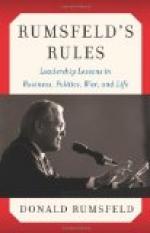The other way was to follow the railway line or lines from the Cape ports, to collect the Army on the Orange River and advance to Bloemfontein, and thence towards Pretoria or towards the western exits from the passes through the Drakensberg mountains. This plan, however, gave no immediate certainty of an opportunity to attack the Boer army. The British force could be assembled on the Orange River no sooner than on the south bank of the Tugela. But from the Orange River to Bloemfontein there would be a march of one hundred and twenty miles, and the Boer army was not at Bloemfontein. There was a probability that when the British force reached Bloemfontein the Boer army might leave Natal, but the probability did not amount to certainty; it rested upon a guess or hypothesis of what the Boer general or the Free State Government and its troops would think. Supposing, however, that these persons did not think as was expected; that they determined to complete the conquest of Natal (except Durban, which was protected by the fleet), and to keep their grip upon Ladysmith, at any rate until the British force was nearing the passes of the Drakensberg or crossing the Vaal, and then, but not till then, to retreat to Middleburg? In that case the purpose of the advance, the crushing of the Boer army, might be deferred for a very long time, and meanwhile every one of the minor tasks, except the relief of Kimberley and the repulse of the Free State invaders of the Cape, would be left over. Ladysmith might fall, and its fall stimulate the Cape rising and endanger the communications of the British force advancing north of the Orange River.
These were the two plans, and I confess that my own judgment at the beginning of November inclined to the former, though, as I am aware that most of those whose strategical judgment I respect hold a decided opinion the other way, I cannot be dogmatic. The prevalent opinion attaches more importance than I can persuade myself to do to the difficulties of the hilly and mountainous country of northern Natal. There is, moreover, a reserve imposed upon observers at home by our ignorance of the state of the transport services of the British forces. No concentration of troops is profitable if the troops when collected cannot be fed.
Subject to these reserves it may be said that Sir Redvers Buller at the beginning of November had to choose between two lines of operations, that by Natal and that by the Cape. The cardinal principle is that you must never divide your force between two lines of operations unless it is large enough to give you on each of the two lines an assured superiority to the enemy’s whole force. Sir Redvers Buller’s design, however, violated this principle. He neither determined upon action with all his might through the Cape Colony nor upon action with all his might through Natal, but divided his effort, directing four of his seven brigades to Natal and the other three towards the Orange River; half his cavalry brigade going to Colesberg, and a mixed force of the communication troops to Sterkstrom on the East London line.




